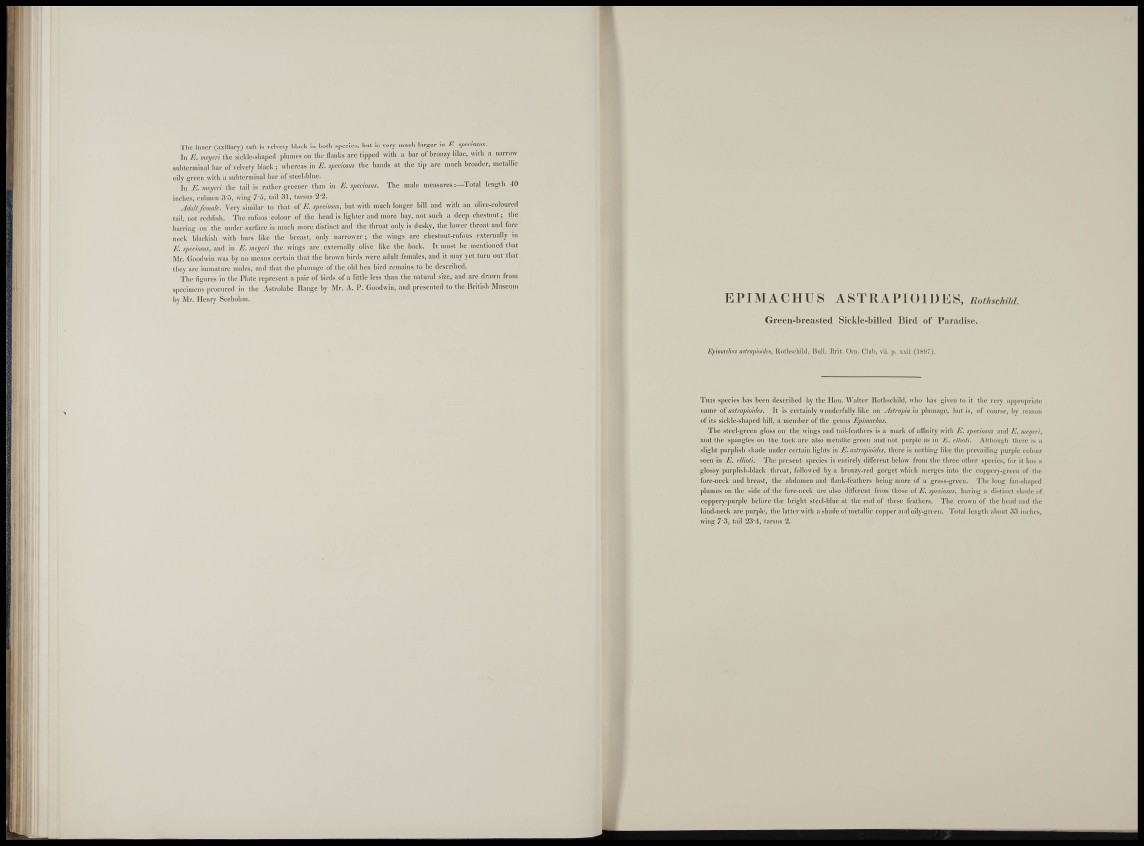
The inner (axillary) tuft is velvety black in botli species, but is very im.cl. larger in E. speciosm.
In E. mcjcri the sicldc-shaped pinnies on the flanks are tipped with a bar of bronzy lilac, with a narrow
snbterrninal bar of velvety black ; whereas in E. spedosus the bands at the tip are nii.cb broader, metallic
oily green with a snbterniinal bar of steel-blue.
In E. mcj/eri the fail is rather greener than in E. speciosus. The male measures :—Total length 40
inches, ciilinen .'S'O, wing 7'5, tail 31, tarsus 2-2.
Adult female. Very similar to that of £ speciosm, but with much longer bill and with an olive-coloured
tail, not reddish. The rufous colour of the head is lighter and more bay, not such a deep chestnut; the
barring on the under snrface is nincli more distinct and the throat only is dnsky, the lower throat and fore
neck blackish with bars like the breast, only narrower; the wings are chestnut-rufous externally in
E. speciosus, and in E. meyeri the wings are exteriiiilly olive like the back. It must be mentioned that
Mr. Goodwin was by no niemis certain that the brown birds were adult females, and it may yet turn out that
they are immature males, and that the plnmage of the old hen bird remains to be described.
The figures in the Plate reiiresent a pair of birds of a little less than the natural size, and arc drawn from
s|)ecimeirs procured in the Astrolabe Range by Mr. A. 1'. Goodwin, a.ul presented to tlie British Museum
by Mr. Henry Scebolini. EPIMACHIJS ASTRAPIOIDES, iiothMi.
Green-breasied Sickle-billed Bird of Paradise.
Ephmcluis astrapwuh'.s, Rothschild, Bull. Brit. Oni. Club, vii. p. xxii (18i)7).
THIS species has been (lescril)e(l by tlie Hon. Walter Kothscliild, who has g'iveii to it the very apjiropriate
name oi^ aatrapioidea. It is certainly wontlerfully like an Astraplu in phi mage, but is, of course, by reason
of its sickle-shaj)e(l bill, a member of the genus Ephnachus.
The steel-green gloss on the wings and tail-feathers is a mark of affinity with E. apeckms and E. meyeri,
and the spatigles on the imck are also metallic green and not j>urj)le as in E. dlloti. Although there is a
slight purplish shade under certain lights in E. axtrapioldcs, there is nothing like the prevailing jjurple colour
seen in E. ellioti. The jjresent species is entirely diiierent below from the tiiree other sjiecies, for it iias a
glossy purplislt-hlack throat, followed by a bronzy-red gorget which merges into the copj)ery-green of the
fore-neck and breast, the abdomen and ilank-feathers being more of a grass-green. The long fan-shaped
plumes on the side of the fore-neck are also diiierent from those ni'E. speciosun^ having a distinct shade of
coppery-jjurple before the briglit steel-blue at the end of these feathers. The crown of the head and the
liind-neck are ])uri)le, the latter with a shade of metallic cojiper atid oily-green. Total lengtli about inches,
wing 7-3, tail 23-4, tarsus 2.
•ll.i